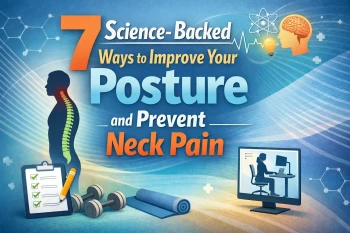
Vertigo is the sense of you or your environment spinning, or in movement, while you are standing still. The most common cause of vertigo is benign paroxysmal positional vertigo which occurs when there is a certain change in your head position, like tipping the head up or down. benign paroxysmal positional vertigo is rarely serious unless it increases the risk of you falling.
Benign Paroxysmal Positional Vertigo Symptoms
Also known as BPPV, benign paroxysmal positional vertigo, symptoms include brief episodes of mild to intense dizziness that tend to arise without reason. The signs and symptoms of benign paroxysmal positional vertigo include the following:
- Nausea
- Vomiting
- Loss of balance or unsteadiness
- Dizziness
- A sense that you or your surroundings are spinning or moving (vertigo)
The symptoms associated with benign paroxysmal positional vertigo can come and go, usually lasting no more than a minute at a time. In addition, episodes of benign paroxysmal positional vertigo can disappear for a while before reoccurring.
Certain activities can trigger your benign paroxysmal positional vertigo symptoms, but these activities can be different for everyone. Most of the time, a change in the head position can trigger benign paroxysmal positional vertigo as well as feeling out of balance as you stand or while walking.
Nystagmus, abnormal eye movements, is commonly seen with benign paroxysmal positional vertigo symptoms. This is a vision condition in which the eyes make repetitive, uncontrollable movements that can result in reduced vision and depth perception – further affecting your balance and coordination. These eye movements may occur in a circular pattern, move side to side, or up and down.
When it comes to daily life, benign paroxysmal positional vertigo can interrupt many tasks throughout the day and change your quality of life. Not only can benign paroxysmal positional vertigo affect your emotional state but can have an effect on your functional and physical aspects as well.
Quality of Life Changes
When living with benign paroxysmal positional vertigo, it is not unusual to feel depressed because of the issue or affect confidence when an episode occurs in public. There are little triggers that can be easily overlooked by those who have never encountered BPPV and this can sometimes be troubling for both the person living with BPPV and the person around them.
Some sufferers may experience additional stress placed on their family and friend relationships. This is can be because of a variety of reasons:
- Trouble in the strenuous yard or housework
- Occurs during vigorous activities such as sports, dancing, or chores
- Walking outside increases the symptoms of BPPV
- Difficulty in concentration
- Restriction in traveling in fear of episodes
- Restrict self in participating in social activities (movies, parties, dinner, etc.)
It is easy for life with benign paroxysmal positional vertigo to become frustrating and make you feel depressed. To many sufferers, it feels like they are missing out on many opportunities or constantly feel interrupted with their episodes.
Even though benign paroxysmal positional vertigo is rarely serious, it can still take a toll on how you feel and how you live your daily life.
What Causes Benign Paroxysmal Positional Vertigo?
The cause of benign paroxysmal positional vertigo lies within your inner ear. An organ called the vestibular labyrinth includes three semicircular canal structures containing fluid and fine, hair-like sensors.
These structures observe your head rotation while the otolith organs located in the ear overlook your head’s movements and its relation to gravity. Within these otolith organs reside crystals that make you susceptible to gravity.
Due to various reasons such as the natural aging process, injury, or condition, the crystals in the otolith organs can be dislocated and move into one of the semicircular canals located in the vestibular labyrinth.
When this happens, this can cause the semicircular canal to respond to changes in your head position that it will typically not react to. It is this response that can make you feel dizzy and cause benign paroxysmal positional vertigo to occur.
Natural BPPV Relief
The good news is there is a natural treatment option for those fighting benign paroxysmal positional vertigo. Since the cause lies within the inner ear, it only makes sense to go with a natural treatment option that will help your inner ear.
To relieve BPPV, the common treatment options are canalith repositioning and surgical procedures. However, there is another treatment option many patients have found great success in called upper cervical adjustments.
Upper cervical adjustments are a type of chiropractic that, unlike other chiropractic, most of us are familiar with, focuses on the area located beneath the base of your skull. In upper cervical adjustments, very gentle, precise movements are used to help adjust your upper cervical spine to remove interference.
There is no “cracking” of the bones involved in this type of chiropractic.
Unlike the rest of your spine, the upper cervical area protects your brain stem. When there is a misalignment in the upper cervical area, the vertebrae can apply pressure onto the brain stem and distort your body’s signals and natural functions.
Correcting your upper cervical spine will remove any pressure pressed upon your brain stem – allowing your brain and body to communicate effectively to repair and heal itself.
What does this have to do with benign paroxysmal positional vertigo? Well, when adjustments are made to the upper cervical spine, this helps readjust the structure of your ear and the crystals of the ear can fall back into place.
Many patients who suffered from benign paroxysmal positional vertigo have seen astounding results from upper cervical adjustments in as little as one treatment even after surgery. This is because although surgery can help relieve some symptoms, it does not take care of the underlying problem that has caused your crystals within the ear to fall out of line in the first place.
Depending on the severity of the misalignment, more adjustments may be needed. However, the goal of the upper cervical chiropractor remains the same: To adjust the body as little as possible until it heals and repairs itself enough to hold the correction on its own.




Leave a comment